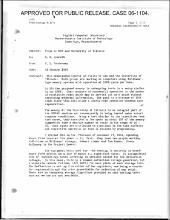| dc.contributor.author | Corderman, C. L. | en_US |
| dc.date.accessioned | 2009-05-08T05:15:47Z | |
| dc.date.available | 2009-05-08T05:15:47Z | |
| dc.date.issued | 1952-01-21 | en_US |
| dc.identifier | MC665_r05_M-1379.pdf | en_US |
| dc.identifier.uri | http://hdl.handle.net/1721.3/39220 | |
| dc.description.abstract | This memorandum reports on visits to ERA and the University of Illinois. Both groups are working on computers using Williams-type memory systems with operation at 1024 spots per tube.
At ERA the proposed memory is undergoing tests in a setup similar to our STRT. Their measure of successful operation is the number of repetitive reads which may be carried out on a point without destroying adjacent information. The goal is a minimum of 1024 reads since this will allow a useful read operation between each regeneration.
The memory at the University of Illinois is an integral part of the ORDVAC machine and consequently is being tested under actual computer conditions. Using a test similar to the repetitive read test above, they encounter a few spots on about 10% of memory tubes which have a maximum number of reads in the range of 10 - 20. Such spots are attributed to blemishes on the tube surfaces and repetitive operation on them is avoided by programming. | en_US |
| dc.language.iso | en | en_US |
| dc.publisher | MIT Digital Computer Laboratory | en_US |
| dc.relation.ispartofseries | MIT DIC 6889 | en_US |
| dc.relation.ispartofseries | Project Whirlwind Memo M-1379 | en_US |
| dc.relation.ispartofseries | Project Whirlwind Collection, MC665 | en_US |
| dc.title | Tripe to ERA and University of Illinois | en_US |
| dc.type | Technical Report | en_US |
